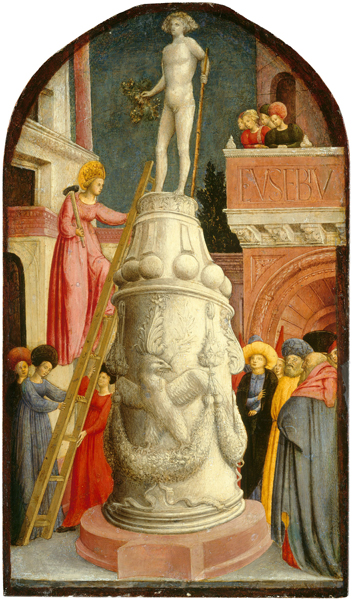Saint Apollonia Destroys a Pagan Idol

Giovanni d’Alemagna
Saint Apollonia Destroys a Pagan Idol, c. 1442/1445
Tempera on panel, 59.4 x 34.7 cm (23 3/8 x 13 11/16 in.)
National Gallery of Art, Washington, DC, Samuel H. Kress Collection
Image courtesy of the Board of Trustees, National Gallery of Art
1) Q: The painting represents events that reportedly occurred several hundred years before the artist’s lifetime. What details did he include to help bring the scene to life?
A:
- Costume details such as oddly shaped hats
- Meticulously rendered architecture
- Latin inscription
- Practical details such as the hammer and the ladder
- Naturalistic poses and actions such as Saint Apollonia climbing the ladder and the women steadying the ladder, bracing themselves
2) Q: Why do you think the artist chose this particular moment—why not simply show Saint Apollonia standing beside a shattered sculpture?
A:
- Greater element of suspense; we see the future prefigured; example of a “pregnant” moment, which suggests more than one instant of time
- Opportunity to represent classical statuary, which satisfies three considerations:
1) A fashionable accessory
2) Allows the artist to draw on his knowledge of the antique to restore fragments and ruins to their past state of wholeness; the reconstruction demonstrates artist’s learnedness
3) Shows off the painter’s skill in realistic painting
3) Q: Who or what is the focus of this painting: Saint Apollonia or the pagan idol? Use visual evidence to support your argument.
A: Consider initiating the discussion with a show of hands. Or you might ask students to answer the question in debate style, assigning one student (or team of students) to argue for Saint Apollonia and the other for the pagan idol.
- The pro-Apollonia argument might include:
- The artist calls attention to her high earthly and heavenly stature through the crown and halo.
- She is the only active agent in the picture, while all others are either passive or attending to her in some way.
- The pro-idol argument might include:
- The prominence of the pedestal and statue at the center of the composition
- It is physically larger than any other element and taking up a great deal of pictorial space (the base actually impinges on the viewer’s space).
- The white marble is among the lightest elements in the painting and therefore eye-catching.
- Greater detail is devoted to this passage than to any other.
- The antique imagery suggests erudition, raising the painting’s intellectual ambitions.